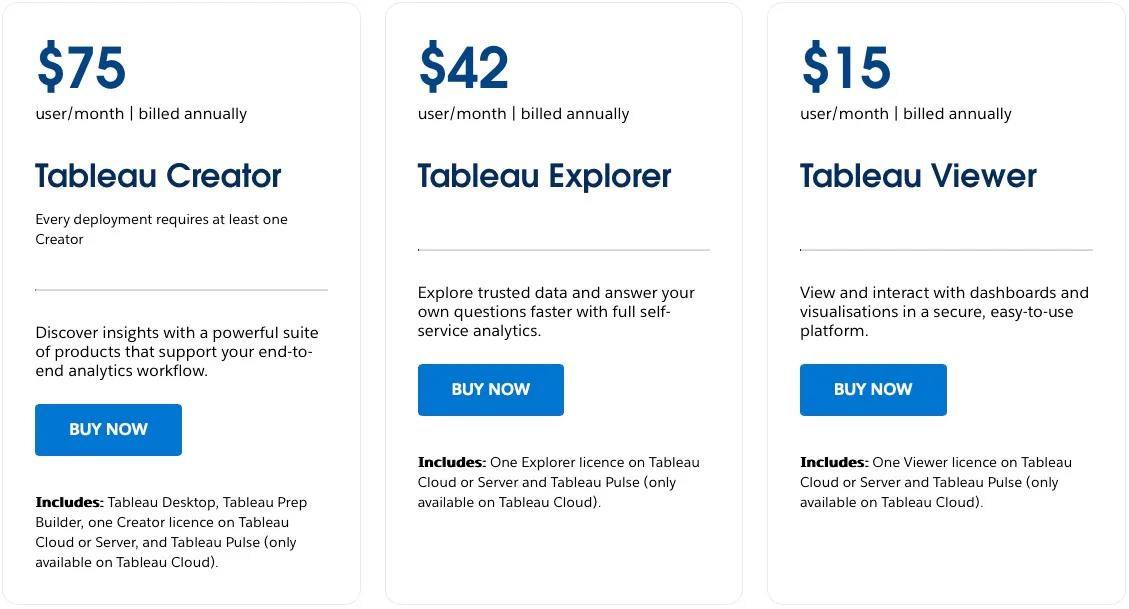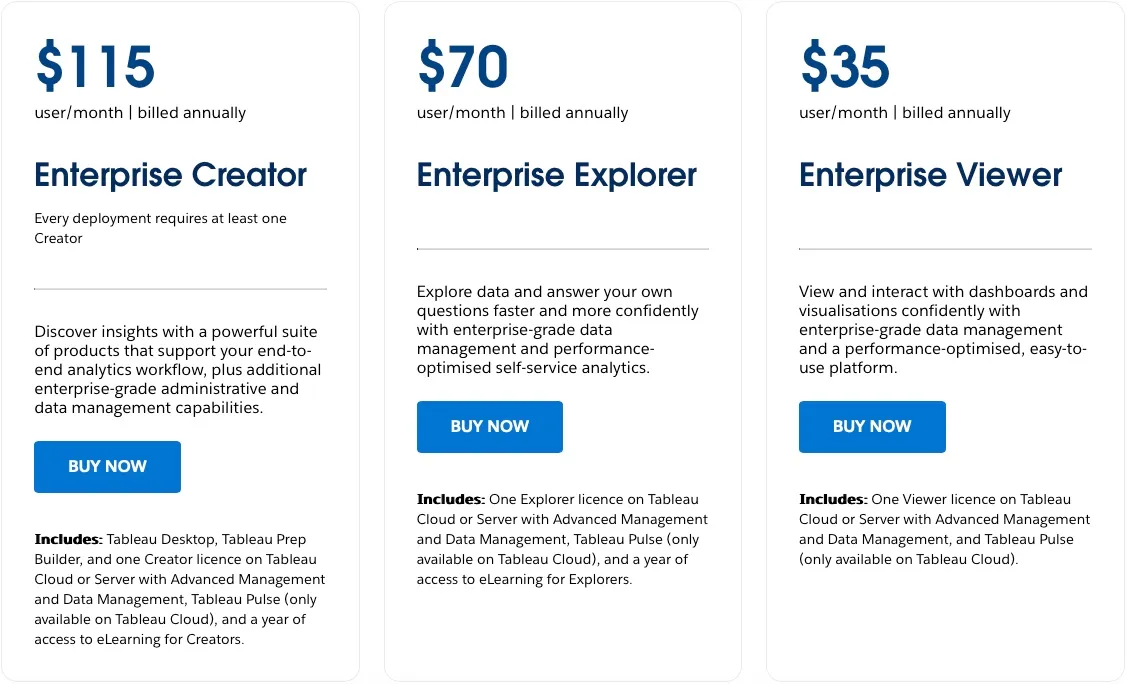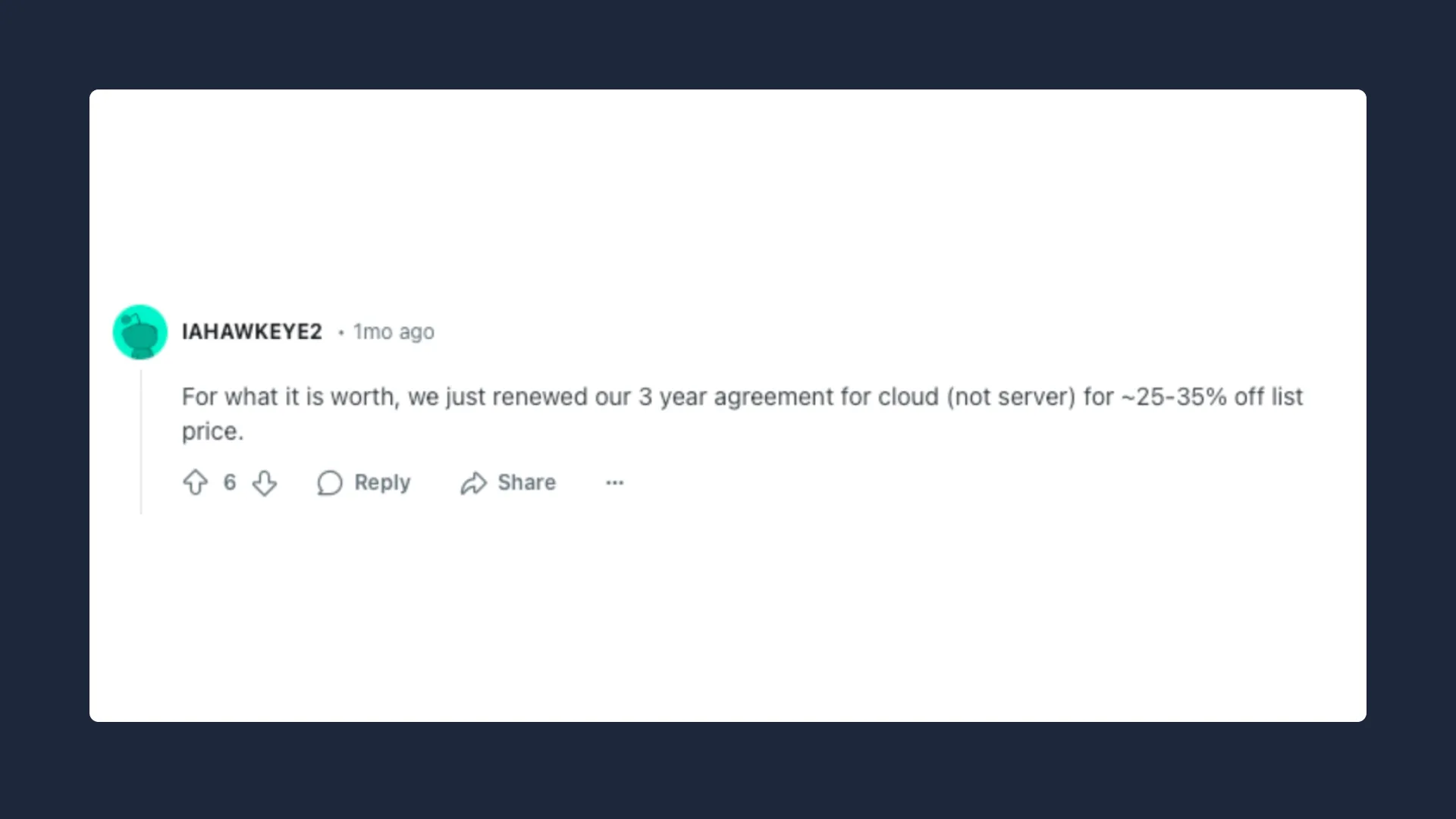



Take a self-guided tour of the platform.
Buying or renewing Tableau?
See why Vertice is trusted by top procurement leaders.
List prices are rarely set in stone. You could be saving up to 30% on average – possibly more.



Data visualization platform, Tableau, powers business intelligence at some of the world’s leading tech companies, supporting analysis and decision making for the likes of Verizon and Lenovo.
Now under the Salesforce umbrella, the vendor has been recognized as a Gartner Magic Quadrant Leader every year for the past decade – reflecting its strong performance and innovation in the analytics software market.
The question is, how much does Tableau cost?
Below, we’ve covered everything you need to know about Tableau’s pricing plans, along with guidance on how you can secure a discount.
How much does Tableau cost?
Tableau is almost entirely transparent with its pricing, opting to list all costs publicly on its website, with the exception of its premium plan, Tableau+.
What many companies aren’t aware of, however, is that these prices aren’t necessarily set in stone – companies can almost always secure a discount, at least with the right leverage and negotiation strategy.
Before we outline the steps that can be taken to drive down the cost of a Tableau subscription, it’s worth understanding the different plan types on offer, and the prices listed on the site.
Tableau pricing plans
The vendor offers three different editions of its product; Tableau, Enterprise, and Tableau+. With the Tableau and Tableau Enterprise plans, there are a further three license types to choose from – Viewer, Explorer, and Creator.
So, how much does each Tableau pricing plan cost?

Tableau Viewer
Tableau license pricing for its Viewer plan costs $15 per user, per month, and provides access to dashboards, visualizations, and analytics tools. On this subscription tier, users can leverage detailed data insights for decision making, with access to features such as visualization summaries, data quality warnings, and basic collaboration functionality.
Tableau Explorer
Tableau Explorer is a more advanced plan, costing $42 per user, per month. Explorer enables users to leverage self-service analytics with governing capabilities, a range of collaboration tools, and some basic data flow functionality.
Tableau Creator
Tableau Creator is priced at $75 per user, per month, and supports teams with a powerful suite of data visualization tools, including Tableau Desktop and Tableau Prep Builder. It also provides one Creator license on Tableau Cloud.

Tableau’s Enterprise edition is available on Tableau Cloud and Tableau Server, and offers more advanced features and functionality than the more comprehensive plans. This includes access to data management and eLearning, while also enabling companies to create 10 sites as opposed to three.
Tableau Enterprise Viewer
Tableau Enterprise Viewer will set organizations back $35 per user, per month. On this plan, users can view and interact with both dashboards and visualizations, making it ideal for those requiring access to data, but who don’t have the time or need to conduct their own analysis.
Tableau Enterprise Explorer
Enterprise Explorer is designed for users looking to explore data and obtain answers to their own questions at speed. This plan is priced at $70 per user, per month.
Tableau Enterprise Creator
Designed with analysts in mind, Tableau Enterprise Creator provides access to a powerful suite of products that support user’s end-to-end analytics workflow, and is priced at $115 per user, per month.
It is worth noting that each Tableau deployment requires the purchase of at least one Creator license, which can bring up the overall price of your annual Tableau subscription.
To give you an idea of what the total cost could look like, we’ve provided a breakdown based on an organization using 20 Viewer licenses, 10 Explorer licenses, and one Creator license, all on Tableau’s basic tier.
- 20 x Viewer ($15 per user per month) = $300 per month, annual billing of $3,600
- 10 x Explorer ($42 per user per month) = $420 per month, annual billing of $5,040
- 1 x Creator ($75 per user per month) = $75 per month, annual billing of $900
- Total billing of $9,540 per year
How much does Tableau+ cost?
Tableau+ is the company’s most comprehensive package that is designed to enable all departments across an organization to easily access, analyze, and utilize data independently. It is the only plan type that leverages AI, allowing for more intuitive and personalized insights.
Like with many enterprise-grade plans, Tableau+ pricing is entirely bespoke, dependent on the specific needs of the organization.
Here’s the issue, though.
Entering into a sales conversation with zero frame of reference on pricing will typically leave you paying substantially more than is necessary. In fact, our data indicates that across all SaaS applications, companies are overpaying by an average of 26%.
The question is, how can you obtain this frame of reference and gain the right leverage to give you more purchasing power in your negotiations?
How to get a discount on Tableau pricing
Whether you're aiming to secure savings on one of Tableau's standard or enterprise plans, or you're seeking the best possible price for Tableau+, the right approach can make both a reality.
You just need intel.
So, what are your options?
Searching the internet for customer comparisons
To start with, you can scour the internet for anecdotal information about how much other companies are paying for Tableau.
A quick search shows that one organization was charged between $150K and $200K per year for a corporate licence a few years ago. The problem, however, is that it’s not clear what a corporate license actually is, and given that software prices rise by an average of 11.4% each year, it’s likely that this price point is no longer relevant.

Another company in a more recent post didn’t go as far as stating the actual cost of their Tableau subscription, but they did explain that they were able to renew their 3 year agreement for Tableau Cloud with a 25-35% saving on the list price.

Gaining real-time insight with pricing benchmarks
While the figures found online can help to provide a ballpark figure, they do also need to be taken with a pinch of salt.
In most cases, they won’t provide relevant context such as the number of licenses that were purchased or even the specific plan type, and even if they do, these price points can very quickly become outdated.
The only accurate way to find out what you can expect to pay for Tableau is by obtaining real-time pricing benchmarks – the exact costs that companies similar to yours are paying for their subscriptions.
Additional tactics for lowering the cost of a Tableau subscription
Commit to a longer subscription period
Many vendors are looking to ensure your repeat custom, which means they will usually offer discounted rates if you subscribe for a longer period.
In Tableau’s case, the vendor already asks for an annual contract commitment, but proposing a multi-year plan could yield further savings.
According to our data, providers tend to offer an extra 5% discount for each additional year that a user commits to. So, if you’re confident that Tableau is the right business intelligence solution for your organization, it might be beneficial to discuss a longer subscription period.
Allow sufficient time for negotiations
Whether you’re purchasing a Tableau license for the first time or moving across from a competitor intelligence platform such as Microsoft Power BI, you’ll need to leave yourself adequate time to research and secure a good deal.
A generous lead time for negotiations ensures that you’re prepared with any competitor quotes, vendor terms, and pricing insights that could earn you a competitive rate. Plus, a little extra time means that you won’t be in any dire need of a fast turnaround to be onboarded, which if vendors realize, could lead them to be inflexible in the terms they offer.
So, if you’re looking to gain insights into campaign progress by a certain date or perform predictive modeling for a new fiscal year, you’ll want to start negotiating far in advance to secure the best possible deal.
Renewing Tableau? Companies save an average of 74% when starting negotiations for their analytics tools at least 90 days in advance of their renewal date.
Partner with a SaaS negotiation expert such as Vertice
At Vertice, we don’t just provide you with the benchmarking data, we use this data to negotiate on your behalf, securing you the very best price and terms on any contract – Tableau included.
Get a better idea of what it means to outsource your procurement, or alternatively see for yourself how we helped one company save 115 hours on contract negotiations in the space of a few months, or how we saved another $155,000 on a single contract through our white glove service.
.webp)
















